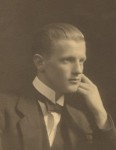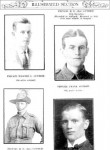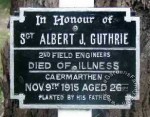Albert John Guthrie enlisted in Melbourne on 26 January, 1914. He was one of four brothers, all of whom volunteered and enlisted just nine days after his brother, Henry David Guthrie, had enlisted in Perth. The brothers were the sons of David Guthrie, a tobacconist, and his wife, Eliza Ann, nee Harvey. Bert Guthrie was 24 years old, single and a carpenter by trade, living at 54 Powlett Street, East Melbourne. He described himself as 5' 8" tall, with 'straight fair hair', blue eyes and a fair complexion. Henry was 28, a clerk and living at home at 722 Hay Street, Perth. Both named their father as next of kin. Both had had previous military service with the different Light Horse units in Perth. Bert Guthrie was placed as a Sapper with the 2nd Field Company Engineers, while Henry joined A Compnay, 11th Battalion.
Bert Guthrie left Melbourne with the first convoy of sixteen ships, on the largest one, HMAT Orvieto A3. The Orvieto left Station Pier on 20 October, 1914, for Albany, Western Australia, where they met the rest of the fleet. Henry left on HMAT Ascanius A11 on 2/11/1914. They probably met at Albany and again at the end of the voyage, in Egypt, where they had four months of intensive training.
Both were involved in the landing at Gallipoli, Henry, with the 11th Battalion, in the fight at Anzac Cove. Bert's experience was equally harrowing. The war diary of the 2nd Field Company Engineers tells his story:
The company disembarked in two parties at 7 am and that (No. 2) under Lieutenant Dawkins detailed for water supply. A party under Captain Williams proceeded up Shrapnel Gully, while remainder sank tube wells in various placed at the foot of the gully ... No's 1,3 and 4 Sections of the Company commenced immediately on landing to construct roads in direction of Gaba Tepe and towards firing line and one track to summit of McLagan's Ridge was completed at 4 pm.
The Field Company Engineers constructed roads, but also trenches for the troops, as well as hygiene facilities. Albert Guthrie had a sprained ankle on 1 May, suffered at Gallipoli, then two days later, came down with influenza. His record does not show how long he was away from the front nor what ship's hospital he was placed in. On 25 May, he was promoted to Lance Corporal and on 30 August, to be 2nd Corporal. There is a further reference to him becoming H.Q. Sergeant on his record, but the date is wrong, 14 August, 1915. This was later to cause a slight problem for his father.
On 10 September, after five months at Gallipoli, Bert Guthrie was ill, diagnosed as Gastritis and later as Enteric Fever, an illness caused by poor sanitation and water supplies. He was taken to the 1st Casualty Clearing Station, then to the hospital ship, then on 16 September, via the H S Gascon, to St. David's Hospital, Malta. From Malta, he was sent on H S Karoola back to Britain, where he was admitted to the Red Cross Hospital in Carmarthen, Wales. He died of an internal hemorrhage on 9 November, 1915. His brother Henry was reurned to Australia on H S Barambah on 8 April, 1917, and discharged from further service on 14 September, 1917, having suffered from concussion caused by a shell.
In the death notice in the West Australian, Albert was identified as a Sergeant, but attempts by his father to have this rank verified failed and his gravestone identifies him as a Lance Corporal. He was buried at Carmarthen Cemetery, Carmarthen, in Grave B. 239, but this was a common grave. His body was later disinterred and reburied at Grave No. 238. Section B, marked by a large memorial stone and cross. Both the grave and the plaque identify him as a Sergeant. He is remembered in the Roll of Honour Cards 145 at the Australian War Memorial and on Panel 23 in the Commemorative Area.







